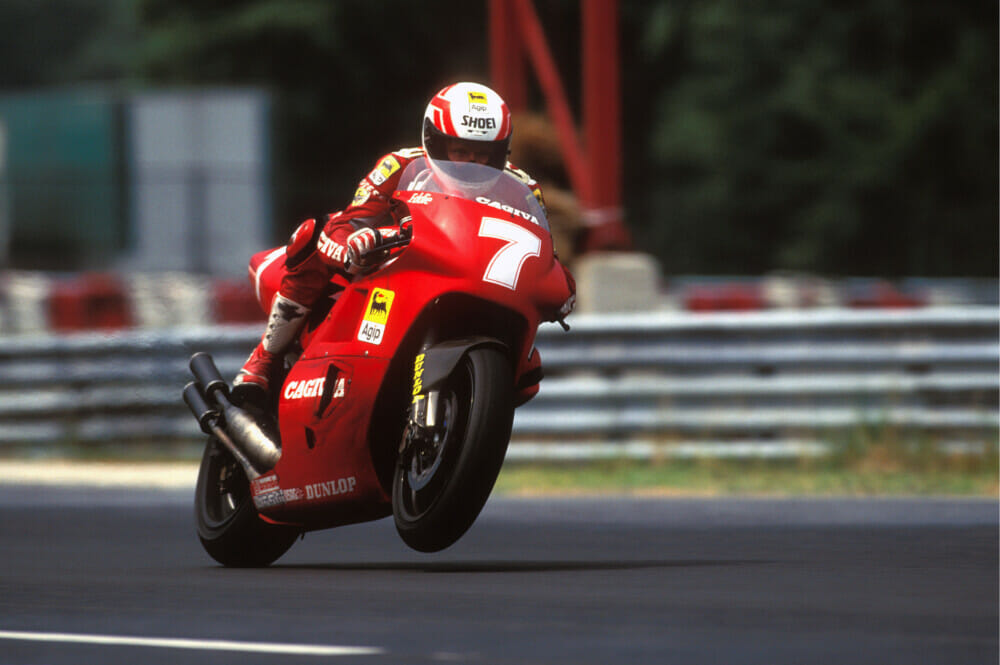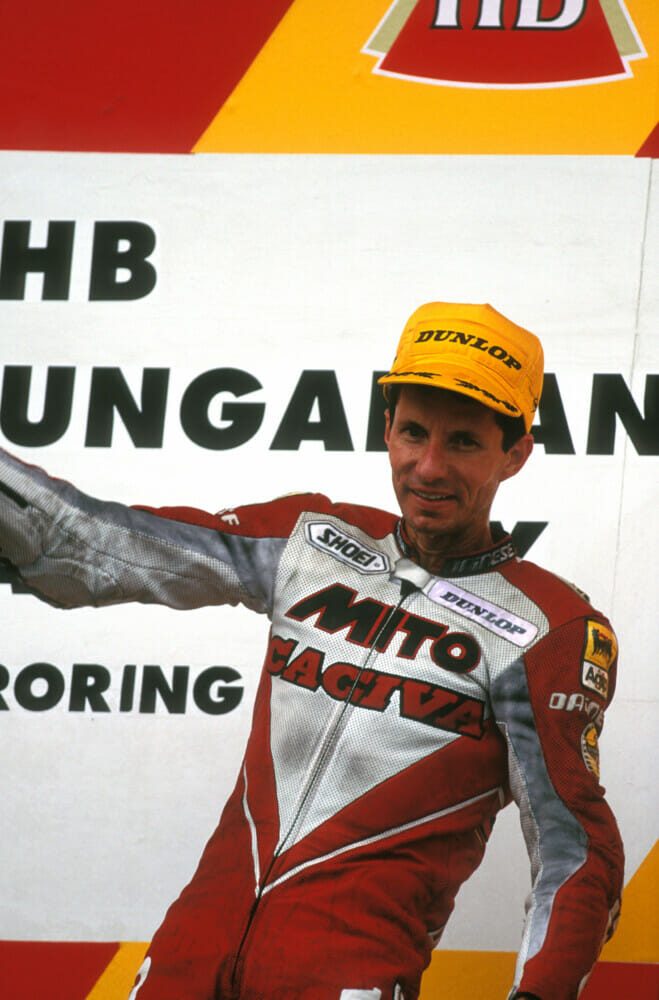Cycle News Archives
COLUMN
Eddie’s First and Last Grand Prix Win
The 11th of July 2022 may have come and passed innocuously enough unless you were a grade A student of MotoGP. The date is significant because it marked 30 years to the day the great Eddie Lawson stood on the top step of the podium for the 31st and final time at the 1992 Hungarian 500cc Grand Prix.

The date also marked the first 500cc win for perennial class strugglers Cagiva, owned by Italian Castiglioni brothers Gianfranco and Claudio, after 12 years of trying, and the first Italian machine to win in the premier class since the Giacomo Agostini won the 1976 German Grand Prix for MV Agusta on the 14-mile Nurburgring Nordschleife circuit.
Lawson had all but retired at the end of a torrid 1990 season with Marlboro Team Roberts on the factory Yamaha YZR500 but as so often happens, an offer came up that was simply too good to resist.
“I had done basically eight, nine years of Grand Prix and I was tired of it. I didn’t want to travel anymore,” Lawson says. “But Cagiva just made an offer I couldn’t refuse,” he says with a financial wink in his eye. “They promised to make the bike better. Eventually after I left, it did get better, and the two years I was there, I think we made a lot of progress.
“Then they kept going with [John] Kocinski. He won some races with it [1993 American Grand Prix, 1994 Australian Grand Prix]. So, eventually it got there. But, when I was on it, it wasn’t there, for sure.”
Lawson notes “no complaints” with the Cagiva chassis, the team experimenting with electronic suspension throughout the 1992 season as well as persisting with carbon-fiber technology for the swingarm that was first pioneered in the 1990 season with Randy Mamola and Ron Haslam, but the engine was the weak point.
“The engine was super heavy, really heavy,” Lawson says. “It didn’t have acceleration, but it had top speed. It had the same top speed as the Yamaha, but it just took a lot of time to get there.
“It didn’t have a lot of bottom or middle. It needed more of that. They kind of put everything on the top-end. I wouldn’t say it was hard to ride or peaky, it just didn’t have what it should have.”
The ninth round of the 1992 championship in the former Eastern Bloc country of Hungary brought with it typically inclement weather, making the tight and twisty nature of the Hungaroring—not to mention all the Armco that lined the track—all the more treacherous.

Class sophomore Doug Chandler, on the Lucky Strike Suzuki, had the bit between his teeth and took the fastest time on Friday after switching to a rear slick right at the end of the session as the spattering of rain gradually dried out.
Not much was thought of it at the time as there was still the matter of Saturday qualifying to get through, but Chandler fooled everyone by doing the exact same thing—this time in the dry—to rocket to the first pole of his young GP career.
Lawson qualified seventh on the blood red Cagiva and would need a miracle if he was to catch his young compatriot in the race proper.
The race was red flagged after one lap when rain drenched the circuit, the field rushing back to the pits to throw full wets on at a time when you could run wets, slicks, intermediates or…
“I just remember being on the line and I told my mechanic, ‘We’ve got to do something different than everybody else, because we’re probably going to get our butt kicked anyway,’” Lawson said. “Everybody had cold wets, and I said, ‘Let’s put cut slicks on.’ Ago [Cagiva Team Manager Giacomo Agostini] was yelling at me, ‘You can’t do that! You can’t do that!’ I told him to piss off. We put them on.”
What followed looked like a step very much in the wrong direction.
VIDEO | MotoGP History: 1992 Hungarian GP 500 First Victory Cagiva
Although Lawson briefly led off the line, Randy Mamola, also in his final GP season, quickly took the lead on his wet-shod Budweiser Yamaha, with Kevin Schwantz up to second, from Wayne Rainey and Chandler.
The young Californian Chandler was on a mission, first passing Rainey, Schwantz and closing a six-second gap down on Mamola to rocket into the lead. Meanwhile, Lawson tumbled down the order to seventh.
“I thought, ‘Oh, man, I really screwed up,’ because it started to rain pretty good in the beginning,” Lawson says. “It was still really wet. That’s why everybody was on wets. Then I thought, ‘Well, if it dries out.’ But a quarter of the way into it, it was still really wet. I went, ‘Well, I did myself here. This isn’t going to work.’
But by the halfway point of the race, the sun appeared, and Lawson’s fortunes began to look as bright as Chandler’s did dark.
“Halfway through, it stopped raining,” Lawson says. “It was starting to develop a dry line, or at least a drier line. Then by about the three-quarter mark, there was a dry line.”
Lawson had almost a minute to make up, but his cut Dunlop slicks were the perfect tool for a track that wasn’t quite dry, but almost. Catching and passing Rainey, Schwantz and Mamola by lapping up to seven seconds faster, the veteran four-time World Champion set his sights on some younger prey in the form of Doug Chandler, whose maiden GP win was slowly but surely slipping through his fingers as his wet weather Michelins gradually ate themselves on the drying track.
With four laps to go, Lawson’s coup de grace on Chandler was swift, but he wasn’t done yet. He continued to pile on the speed as the chasing pack got progressively slower, his margin of victory a staggering 74.194 seconds over Chandler. Third-placed Mamola, who took the final podium place of his GP career, was a massive 97.730 seconds off Lawson.
“I didn’t think there would be enough time to the end of the race, but there was,” Lawson says with the same matter-of-factness that was a trademark of his GP career. “That race was luck, for sure, because it could have gone the other direction real easy. It could have gone sideways real bad. So, part of it was a gamble, and it paid off. That’s all it was. It was fun. It was fun to give them [Cagiva] their first win. I just remember how happy Claudio [Castiglioni] was. Claudio was just out of his mind.”
Lawson duly retired at the end of the 1992 500cc Grand Prix season, leaving his mark with four World 500cc Championship titles (1984, 1986, 1988 on Yamahas and one for Honda in 1989), 31 Grand Prix wins (Yamaha, Honda and Cagiva), 78 podiums and 21 fastest laps to go with his two AMA Superbike and 250cc Grand Prix titles.
He remains the most successful American in the history of Grand Prix racing.CN
Click here to read the Archives Column in the Cycle News Digital Edition Magazine.
Subscribe to nearly 50 years of Cycle News Archive issues
Click here for all the latest Road Racing news.
